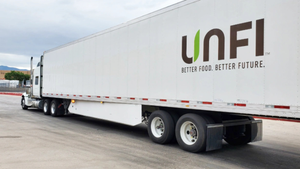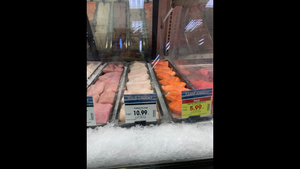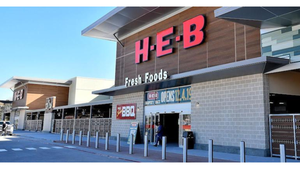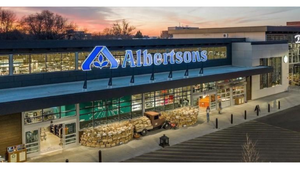Energy Savers
Unlike other retail sectors, food retailers face the enormous challenge of running refrigeration systems, which account for more than half of the electricity costs in their stores.
April 18, 2011
MICHAEL GARRY

At Big Y’s Southwick, Mass., store this unit cut the compressor’s energy usage by 20% on a hot day.
Unlike other retail sectors, food retailers face the enormous challenge of running refrigeration systems, which account for more than half of the electricity costs in their stores.
While these systems are notably fragile and complex – and have a nasty tendency to spring refrigerant leaks – the good news is that advances in technology are helping retailers operate them more efficiently, with significant benefits to their bottom line. Over the past several years, a few pieces of technology — the electronically commutated (EC) motor and LED lighting — have enabled refrigerated and frozen cases to experience marked decreases in energy consumption. But in just the past year, several new refrigeration systems have emerged to drive a further dent in energy costs, including a “hybrid” condenser, a pressure controller and a device that mimics food temperatures in cold cases.
These new devices all have a direct impact on the guts of store refrigeration – the compressors that compress refrigerant gas to set the cooling cycle in motion.
Big Y Foods, a 56-store chain based in Springfield, Mass., has been involved in energy management and conservation for more than 30 years, installing its first energy management system in early 1975. “We’ve always been proactive in seeking out and evaluating new technologies to reduce our appetite for energy,” said Gary Kuchyt, the chain’s energy manager. “This has enabled Big Y to enhance the appearance of our stores and to contribute our part in reducing the release of pollutants into the atmosphere.”
Two of the chain’s most recent energy management efforts include the installation of EC motors in evaporator fans for refrigerated cases and walk-in coolers throughout the chain, and the implementation of a hybrid condenser in the refrigeration system of two stores.
Both projects were part of Big Y’s overall energy reduction plan, which includes installing LED lighting as frequently as possible and using case curtains when a store is closed. The plan has been paying dividends: Since 2004, Big Y has added more than 700,000 square feet of retail space, yet projected kilowatt consumption for 2011 has only increased by 3.5%, Kuchyt said.
With any new technology, noted Kuchyt, Big Y prefers to do a small pilot test “to see if the product performs as advertised.” The chain hired National Resource Management (NRM), Canton, Mass., to retrofit the walk-in coolers, freezers and refrigerated cases in two Connecticut stores with EC fan motors and monitor them for about nine months. The motors, which blow air across the evaporator coil to facilitate cooling, were supplied by Morrill Motors, Erwin, Tenn.
“We were very satisfied with the end results” of the pilot, said Kuchyt. Big Y proceeded to roll out a retrofit program chainwide in 2009 to replace existing permanent-split-capacitor (PSC) fan motors in all cases and walk-in coolers with EC motors, completing the job last year. Each store took about 1-½ to two days to install an average of between 100 and 150 motors, “with minimal disruption to the customers,” he said. The average cost per store was $22,750.
The EC motors produced an energy savings of 55% in cases and 65% in walk-in coolers. Big Y was also able to secure incentive dollars from local utility companies covering 40% of the cost of the EC motor retrofits. The incentives, coupled with energy savings, enabled Big Y to see a payback for the motors in a little over two years, said Kuchyt.
EC motors have evolved over the past several years to where they represent an energy-saving alternative to existing PSC and shaded pole motors, though EC motors are about twice as expensive, said Jim Staley, chief operating officer, NRM. But whether retailers decide to retrofit existing cases with them depends on local energy rates and the availability of utility incentives, which will determine the ROI. Rates in Big Y’s New England market tend to be high – between 10 cents and 18 cents per kilowatt-hour – buttressing the argument for retrofits.
For the most part, EC motors have become a standard part of new cases, Staley noted. In fact, they have been a required part of all walk-in coolers installed since Jan. 1, 2009, per the federal Energy Savings and Independence Act of 2007.
Another New England food retailer that has benefited from the installation of EC fan motors is Stop & Shop, Quincy, Mass., which is seeing a 50% reduction in fan energy consumption, said Mark Macomber, energy project manager, Stop & Shop.
The chain is expected to retrofit its walk-in coolers at all of its Stop & Shop stores and those of sister Ahold USA division Giant of Landover, Md. (about 560 stores) by the end of 2011 to mid-2012, with EC motors from Regal Beloit, Beloit, Wis., said Macomber. The retrofits are being handled by Bluestone Energy Services, Norwell, Mass. All of Stop & Shop/Giant’s refrigerated and frozen cases already came with EC motors, so there was no need to retrofit them, he noted.
Stop & Shop is now turning its attention to another sister division, Giant Food of Carlisle, Pa., which is in the process of being evaluated for energy retrofits. The Mid-Atlantic has better energy rates and fewer utility incentives, making it more challenging to identify ripe retrofit prospects, Macomber said.
Bluestone Energy Services has also implemented other energy-saving measures for Stop & Shop and Giant of Landover, including LED lighting in frozen-food case doors, which is about 40% complete, according to Macomber.. For energy projects completed between 2008 and 2010, Stop & Shop saved about 27 million kilowatt hours of energy and about $4 million, he said.
Handling Hot Days
Located on store rooftops, the condenser is the part of a supermarket refrigeration system where the refrigerant gas is liquefied and discharges its heat to the environment. Muller Industries, Irvine, Calif., developed the 3C hybrid condenser to mitigate the effect of hot days on rooftop condensers, helping compressors in the motor room run more efficiently. The hybrid unit costs more than a standard air-cooled condenser, but can yield a payback in less than two years, working best in dry climates, said Paul Noreen, vice president of sales and operations, Muller Industries.
Last year, Big Y worked with a local utility company, Western Massachusetts Electric Co. (WMECO), to evaluate replacing an air-cooled condenser with the recently introduced 3C hybrid condenser as part of the renovation of a store in Southwick, Mass. The hybrid condenser was ultimately installed last August.
This year, Big Y installed two hybrid condensers at a store in Stafford Springs, Conn., and plans another installation at a store in Meriden, Conn., said Kuchyt. Moreover, the system figures into Big Y’s future plans: “Our current specification is to use the Muller 3C hybrid condensers,” he said.
At the Southwick store, the hybrid condenser was a service replacement obtained through a wholesaler for the low-temperature refrigeration system, while at the Stafford Springs store it was part of a renovation and was obtained through refrigeration supplier Hussmann.
For Ken Soto, senior technology specialist at Big Y, the hybrid condenser offers Big Y “the best of both worlds” — the simplicity of an air-cooled condenser with the energy savings of an evaporative condenser, using a small amount of water with no chemical treatment.
The hybrid condenser works best on hot summer days when peak energy demand is in play, Soto said. At the Southwick store, Big Y calculated that the hybrid condenser, using its evaporative cooling pads, reduced the compressors’ energy usage by about 20% on an 89-degree August day. At least two out of five compressors were cycled off, yet case temperatures were maintained.
Additional energy savings were achieved via the use of two high-efficiency EC-motor fans instead of the four standard-efficiency fans in an air-cooled condenser. Using variable-frequency drives, the high-efficiency fans lower their speed as the air temperature falls.
“We were attracted to the [hybrid condenser] because of the promised energy savings and capacity increases,” said Tony Coppola, Big Y’s director of facilities, in a case study published by Muller Industries. “The Southwick installation validated those expectations. It is also of great importance, however, that the [condenser] allows us to reduce the amount of refrigerant in the system, and that the [condenser] can be recycled at the end of its useful life. Benefits like this can only help us to make a more positive impact in the communities we serve.”
The utility rebate Big Y obtained for using the hybrid condenser covered half of the project’s cost at the Southwick store, which was $25,000 for the unit plus $12,000 for installation, said Kuchyt. The rebate, energy and refrigerant savings will result in an ROI of about 2 years, he added. Considering all of the benefits of the hybrid condenser — lower operating costs, simplicity, utility rebates and lower refrigerant charge – Soto concluded that it offers Big Y “a superior alternative to existing condenser technologies.”
Other retailers using the hybrid condenser in at least one store include Price Chopper of Schenectady, N.Y.; Whole Foods Market; Giant Eagle; and Fresh & Easy Neighborhood Market, according to Noreen.
Compressor Controls
Two other new technologies are focused on making the compressor work more efficiently. One is a digital pressure controller called PressuRITE, from The Product Group, Newport Beach, Calif.
The device, which measures the refrigerant pressure (high and low) and oil pressure of an individual compressor, replaces mechanical pressure switches, using a solid brass transducer as a sensor. It purports to eliminate refrigerant leaks caused by ruptured capillary tubes and bellows used with the mechanical devices.
“From 25% to 30% of the refrigerant leaks in supermarkets occur in pressure devices,” said Jim Italiano, chief operating officer, The Product Group.
The PressuRITE device is installed in six supermarkets in the U.S., and some distribution centers and cold storage facilities, said Italiano. It costs about $200 per unit, and replaces both oil and refrigerant pressure devices.
Super A Foods, Commerce, Calif., has used PressuRITE devices on each of the compressors in one store for about five months, and recently installed it on one compressor in a second store, said Joe Perry, director of construction and maintenance for the 12-store chain. For now he is employing the device to replace faulty mechanical pressure switches, and is weighing whether to retrofit the remaining switches that are operating adequately.
In one case, a mechanical pressure switch was generating “nuisance alarms” indicating incorrectly that there was an oil failure and shutting down the compressor. The new digital device “reads pressures a lot closer so there are no nuisance alarms,” Perry said, adding that the compressors run more efficiently as well.
As for leaks, Perry acknowledged that they eventually would occur with the mechanical devices and that the digital device “goes a long way to helping out on that.”
Perry said the PressuRITE is “easier to read” and is currently being set up so that it can be read remotely. Even on site, the digital device saves technicians’ time by not requiring gauges to be used and allowing pressures to be read via a handheld monitor. In five months, Perry said Super A has recouped the cost of the devices in maintenance savings alone.
Another new technology that aims to enhance the performance of compressors is called Endocube, from RefrigeratorSaver, New York, the U.S. marketing and distribution arm of London-based Universal Master Products. The device fits over the thermostat probe in a refrigerated case or freezer; inside the device is a scallop-like material determined by NSF International, the auditing agency, to mimic the properties of food and beverages.
The Endocube unit is designed to instruct the back-room refrigeration compressors on how hard to work based on the temperature of food in the case, rather than air temperature. Because food temperature is more stable than air temperature – as well as a better indicator of how much cooling is required – the compressor runs fewer and longer cycles.
According to RefrigeratorSaver, the Endocube allows compressors to run 80% less often (about four starts per hour, rather than 12 to 20), each time running about 10 minutes (rather than three minutes) and expending 10% to 30% less energy; this in turn generates less noise and limits the wear on the compressor. In addition, “natural” defrost can occur without the introduction of heat, the company said.
The Endocube works in concert with a separate thermometer, the Endotherm, which provides the temperature of the food (rather than the air) in the case. The cost of one set of Endocube and Endotherm devices is $200 to $249, including installation. RefrigeratorSaver is partnering with Integrated Control, Huntington, N.Y., to enable retailers to send temperature data wirelessly to their headquarters.
Widely used by stores in the United Kingdom, the Endocube/Endotherm devices are starting to be tested by U.S. grocers. For example, a Compare Foods outlet in Queens Village, N.Y., has been using them in all of its cases for the past two months. Jose Espinal, owner of the store, confirmed that his compressors now come on less often and work longer while keeping food in better condition. The upshot, he added, is that “we spend $1,000 less per month in electricity.” He also reported requiring less defrost for cases and less maintenance overall.
Brentwood IGA, Brentwood, N.Y., recently installed 15 pairs of Endocube/Endotherm devices in five stand-alone cases in its store, including stand-alone beer, Carvel, deli and meat cases, said William Lukeman, owner of the store plus two other IGAs. He expects to install 72 pairs.
In their initial two weeks of operation, Lukeman noticed the devices working effectively. At the stand-alone, five-by-eight-foot, open beer case, the compressors had turned on as many as 19 times per day, but now do so about one-third as often, yet the product remains just as cold, he said. So far the Endotherm device is also functioning well, reading the temperature “inside the food package not the case,” he said, adding, “I’m interested in the food temperature.”
Lukeman is now assessing whether to install the devices in the majority of the store’s cases that are linked to back-room compressors, by doing a before-and-after test of their impact on electricity consumption. “It is new technology, so I was afraid to do the whole thing in one shot without knowing this,” he said. But he expects the technology to help reduce his electrical costs — which he called “astronomical” — by at least one-third. “For our open dairy and meat cases, I won’t be air-conditioning the store, only keeping product at the optimal temperature specified by the Department of Agriculture.” He also expects to see less attrition in the compressors and case fans and to eliminate one defrost cycle.
Gizmo Glossary
Electronically Commuted (EC) Motor: High efficiency motor use in refrigeration fans; powered by direct-direct current (DC) electricity and featuring electronic commutation systems.
Hybrid Condenser: Refrigeration condenser designed to mitigate the impact of hot outdoor temperatures; both air- and water cooled.
Digital Pressure Controller: Measures the refrigerant and oil pressure of an individual compressor; replaces mechanical pressure switches.
Endocube: Tells refrigeration compressors how hard to work by measuring temperature of food in a case.
Endotherm: Measures temperature of the food (rather than the air) in a case.
About the Author
You May Also Like






